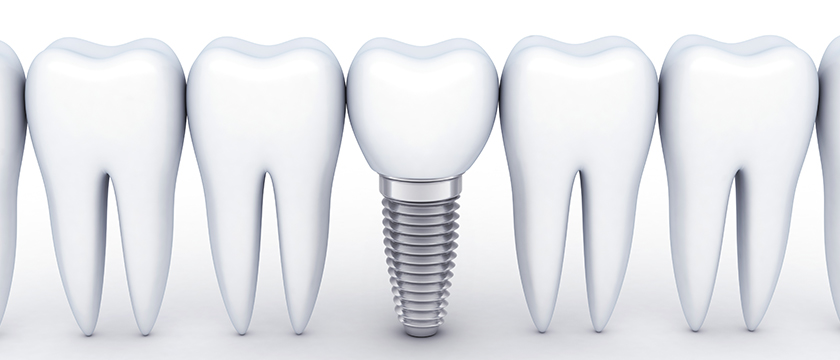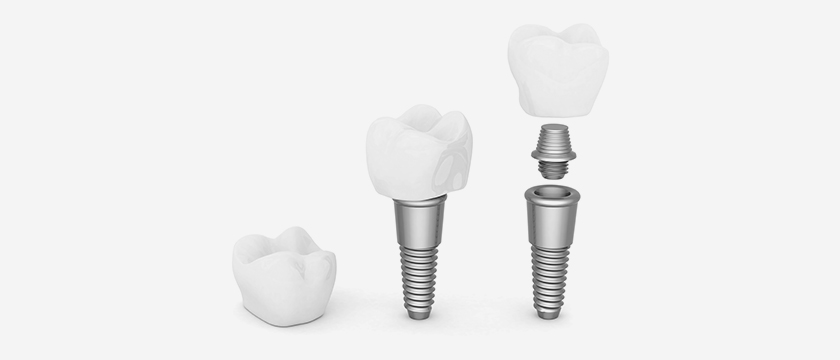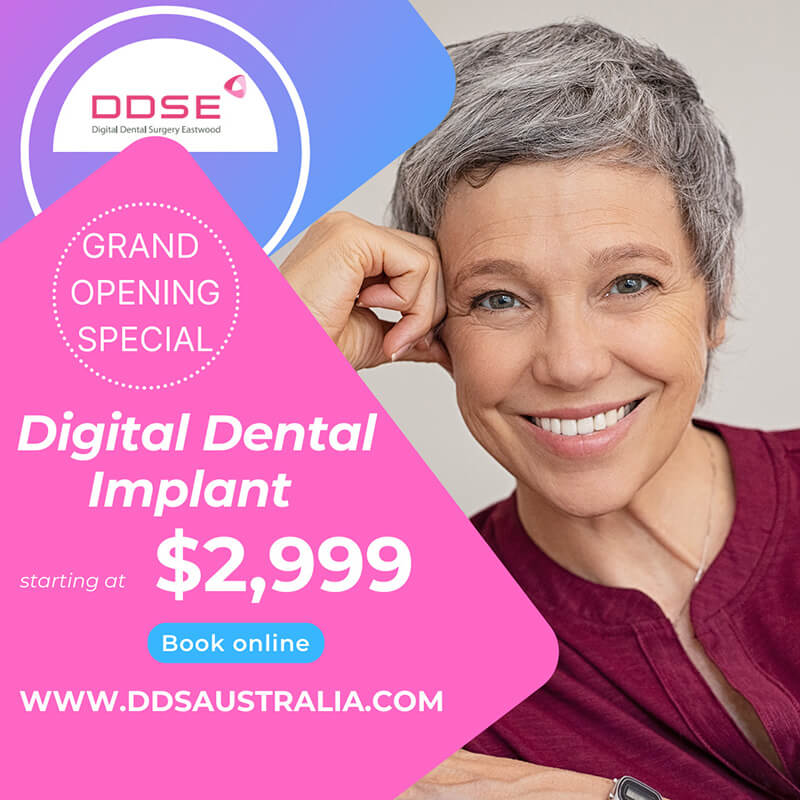Affordable dental implants have emerged as the leading missing teeth replacement solution. They offer a durable, natural-looking option, seamlessly integrating with your jaw bone.
But how exactly do dental implants work, and more importantly, what do they cost? This guide will address these questions and much more, focusing on the Australian perspective and specifically honing in on dental implants in Sydney.
Understanding Dental Implants
Dental implants are an impressive advancement in modern dentistry, offering a reliable solution for missing or damaged teeth. At their core, dental implants are artificial roots that have natural tooth roots’ function and appearance.
Composition and Design
These implants are primarily composed of titanium, a biocompatible material that easily integrates with the human body. The unique feature of titanium is its ability to fuse with the bone, ensuring a stable and durable foundation.
This feature makes dental implants distinct from other teeth replacement options, like dentures or bridges, which might not offer the same level of stability. Consequently, those with implants don’t face the uncomfortable scenario of their replacement teeth slipping or shifting while eating or speaking.
Detailed Procedure:
Consultation: Before any surgical procedure begins, an implant dentist will assess your oral health, take necessary X-rays, and discuss the best strategy tailored to your needs.
- Surgical Insertion: Under local anaesthesia, the dentist surgically places the titanium implant into the jawbone. This acts as a substitute for the tooth root.
- Healing and Osseointegration: This phase is vital. The implant undergoes a process called osseointegration, where it fuses with the bone. This can take several months but ensures the implant offers a solid foundation for the artificial tooth.
- Abutment Placement: Once osseointegration is complete, a connector, formally known as an abutment, is attached to the implant. It acts as a bridge between the implant and the final crown.
- Crown Fitting: After taking an impression of your teeth to ensure a perfect fit and match, the dental crown is then attached to the abutment, finalising the process.
Advantages of Dental Implants
Natural Appearance
One of the most commendable aspects of dental implants is their ability to replicate the aesthetic of natural teeth. They look like real teeth and feel like them, ensuring that once they’re in place, they become virtually indistinguishable from your surrounding natural teeth. The outcome? A radiant, gap-free smile that boosts confidence and self-esteem.
Unparalleled Functionality
Say goodbye to dietary restrictions or the fear of biting into crunchy foods. Dental implants restore the full function of natural teeth. Dental implants ensure you can relish all your favourite foods without any apprehension, whether it’s savouring a crunchy apple, enjoying corn on the cob, or indulging in a juicy steak.
Endurance and Longevity
Dental implants stand out for their longevity. Unlike dentures that may require periodic adjustments or replacements, implants, with proper oral hygiene and routine dental visits, can last a lifetime. This durability translates to fewer visits to the dentist for adjustments and a long-term solution for missing teeth.
Promotion of Bone Health
Beyond their cosmetic and functional benefits, dental implants also play a major component in maintaining bone health. When a tooth is lost, the absence of its root can lead to the gradual deterioration of the jaw bone in that area—a phenomenon known as bone resorption. Dental implants serve as artificial tooth roots, stimulating the bone and preventing bone loss. In essence, they aid in preserving the integrity of your facial structure and jaw bone.
Factors Influencing the Cost of Dental Implants
Choosing to get dental implants is a significant decision, both for your oral health and your wallet. To make an informed choice, one must understand the different components that shape the final dental implant cost. Especially in bustling metropolitan areas like Melbourne, the landscape of dental healthcare is vast and varied. Here’s a more detailed breakdown of the factors influencing dental implant costs:
Type of Implant:
- Single Tooth Dental Implant: As the name suggests, this caters to replacing just one missing tooth.
- Multiple Teeth Implants: This option might be the most suitable if several adjacent teeth are missing.
- Full Mouth Dental Implants: Full mouth implants, often known as “all-on-4” or “all-on-6,” can be the go-to solution for those missing most or all of their teeth.
Material Used:
- Titanium Implant: Predominantly used due to its durability and compatibility with the body. Titanium implants have a proven success record.
- Zirconia Implants: An alternative to titanium, zirconia is a ceramic material that offers a more natural tooth colour but might not be as durable as titanium.
Geographical Location:
The cost of living and operational costs for clinics varies across Australia. Therefore, as a major city, dental implants in Melbourne might have different pricing structures than in rural or regional areas.
Expertise of the Implant Dentist:
Experience matters, especially in intricate procedures like dental implant surgery. While an established implant dentist might have higher fees, the peace of mind and quality assurance often outweigh the added expense.
Additional Procedures:
- Bone Grafting: Bone grafting might be recommended if the jaw bone lacks the necessary density or volume to support an implant.
- Treatment for Periodontal Disease: Gum health is foundational for implant success. If a patient has gum disease, it needs addressing before the implant procedure.
When evaluating costs, the mantra should always be “value over price.” Opting for cheap dental implants may seem tempting, but compromising on quality can lead to complications in the future. Prioritise high-quality dental implants that guarantee both functionality and aesthetics.
Affordable Dental Implants: Cutting Down the Costs
Navigating the financial aspect of dental care can be daunting. However, with a little research and planning, one can make the journey to a renewed smile more budget-friendly:
Dental Insurance:
- Many dental insurance plans recognise dental implants’ long-term value and health benefits, and thus offer partial or full coverage. It’s essential to read the fine print of your policy or have a conversation with your insurance provider. Some might offer major dental cover, which includes a portion of the dental implant costs, while others might have certain prerequisites or waiting periods.
Payment Plans:
- Financial flexibility can be a game-changer. Many dental surgeries in Melbourne and across Australia now provide payment plans, allowing patients to distribute the cost over a more manageable timeframe. This can make the procedure accessible without the immediate financial strain.
Comparing Prices:
- It’s prudent to obtain quotes from various dental clinics. However, it’s paramount to consider the dentist’s expertise, the materials used, and the overall service quality while comparing. Delve into reviews from other dental implant patients to get a real-world perspective on their experiences.
Dental Schools:
- A lesser-known avenue for affordable dental care is dental schools. Leading institutions often run programs where dental students, under the meticulous supervision of their seasoned instructors, perform procedures. While the thought might be intimidating, remember these are often final-year students on the cusp of becoming professionals. They offer services at a fraction of the usual cost, making it an option worth exploring.
In your pursuit of a restored smile, remember that while affordability is crucial, so is quality. Your oral health is an investment, not just in appearance but in overall well-being and quality of life.
Dental Implants Vs. Other Options
The journey to restoring your smile can lead you down various paths. However, when you weigh the advantages and disadvantages of each option, dental implants often emerge as the most beneficial choice. Let’s investigate how they compare with other popular tooth replacement solutions.
Dental Bridges:
- What are they? Dental bridges, as the name suggests, bridge the gap created by missing teeth. A bridge consists of two or more crowns for the teeth on either side of the gap and a replacement tooth or teeth in between.
- Advantages: They can restore your smile, properly distribute the forces in your bite, and prevent remaining teeth from drifting out of position.
- Challenges: One major requirement for a dental bridge is to reduce or grind down adjacent teeth to support the bridge. This reduction can make those teeth more vulnerable to decay and other oral health issues. Additionally, bridges have a finite lifespan and will need replacement after a certain number of years.
- How do Dental Implants Compare? Dental implants, in contrast, don’t demand any alteration of the neighbouring teeth. They stand independently and integrate with the jaw bone, making them a more natural and long-term solution.
Dentures:
- What are they? Dentures are meant to replace lost teeth and the surrounding tissues. They can be complete (replacing all teeth) or partial (filling the spaces left by missing teeth to prevent other teeth from changing position).
- Advantages: They are a traditional solution that can improve the appearance of smiles with multiple missing teeth.
- Challenges: Dentures can often be uncomfortable, especially if they don’t fit perfectly. They can cause sore spots in the mouth, slip or cause speech impediments, and may also lead to eating restrictions.
- How do Dental Implants Compare? Dental implants are stationary, offering a firmness that replicates natural teeth. There’s no slipping, no speech issues, and no discomfort. Plus, they allow for more natural biting and chewing, letting you enjoy a broader range of foods.
Maintaining Your Dental Implants
Taking care of your dental implants is paramount to ensure their longevity and optimal oral health. Here’s a more comprehensive guide on how to do just that:
Regular Brushing:
- Just as with your natural teeth, dental implants need consistent cleaning. Use non-abrasive toothpaste and soft-bristled toothbrush to prevent scratching the surface of the implants. Consider investing in an electric toothbrush for more thorough cleaning.
Flossing:
- Specialised dental floss designed for implants can be used to clean around your implant crown and the gum line. Proper flossing helps remove food particles, prevent gum disease, and ensure the gum tissue around the implant remains healthy.
Regular Check-ups:
- Dental implant patients should have routine check-ups to monitor the health of their implants. The Australian Dental Association recommends visiting your dentist at least twice a year. During these visits, the dentist can ensure the implant is stable, the crown is undamaged, and there are no signs of potential issues.
Avoid Harmful Habits:
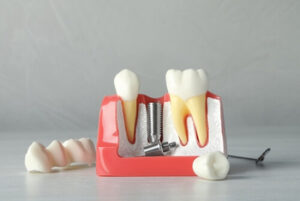
- Chewing on Hard Items: Biting down on hard items like ice, candies, or even pencils can damage the crown or even the implant.
- Teeth Grinding: Known as bruxism, this can exert undue pressure on the implant, potentially leading to damage. If you’re aware of grinding your teeth, especially during sleep, discuss with your dentist about getting a custom-made nightguard. This appliance reduces the pressure on the teeth and implants, ensuring their longevity.
Remember, while dental implants mimic natural teeth in many ways, they require specific care to ensure they remain in top condition. Regular dental care and periodic professional assessments will keep your implants — and your smile — looking their best.
Challenges Tackled by Dental Implants
Over the years, dental implants have addressed many issues individuals face with missing or damaged teeth, offering solutions that were once deemed unattainable.
Speaking and Pronunciation
Having gaps in your teeth can often make it challenging to pronounce certain words correctly. This impacts speech clarity and can dampen an individual’s confidence to communicate freely. Dental implants restore the alignment of the teeth, facilitating clearer speech and boosting self-assurance during interactions.
Mastication and Digestion
Teeth play a pivotal role in the first stage of digestion: mastication, or the process of breaking down food. When teeth are missing or weak, the efficiency of this process is compromised, which can lead to digestive issues. Dental implants provide the strength and stability required to chew food thoroughly, aiding in better digestion and overall health.
Facial Aesthetics and Structure
The tooth loss can lead to the sagging of facial muscles over time, making one appear older. Dental implants support the facial structure, ensuring the muscles remain taut and enhancing one’s appearance.
The Psychological Impact of Dental Implants
It’s essential to understand that the impact of dental implants isn’t limited to oral health and functionality. The psychological benefits are profound.
Restored Confidence
Individuals often find a renewed sense of self-worth with a full set of teeth. They smile more, engage in conversations without hesitancy, and exude a level of confidence that might have been lacking previously.
Improved Social Interactions
Having gaps or visibly damaged teeth can sometimes make individuals self-conscious, leading them to avoid social interactions or public speaking opportunities. Dental implants can alleviate these concerns, making social scenarios more enjoyable.
Freedom from Discomfort
Unlike dentures, which can sometimes cause discomfort or uneasiness due to improper fit, dental implants feel and function like natural teeth. This means users don’t have to deal with the regular inconvenience of removing or adjusting them, leading to improved mental well-being.
The Science Behind Dental Implants:
Material Advancements
The success and popularity of dental implants can be credited, in part, to the materials used. Renowned for its biocompatibility, titanium ensures the body doesn’t reject the implant. Its ability to osseointegrate or fuse with the bone provides unparalleled stability.
Innovative Techniques
Modern dental implant procedures have evolved with the help of technological advancements. Techniques like 3D imaging and computer-guided implant surgeries have allowed for greater precision in implant placement, reducing recovery times and enhancing success rates.
Bone Grafting and Dental Implants
Not every patient is immediately eligible for dental implants. Those with inadequate jaw bone mass may need bone grafting so that the implant has a sturdy foundation. This procedure involves transplanting a piece of bone from another area of the patient’s body or using a synthetic bone, to the jaw. Over time, this graft builds up the bone area, making it viable for the implant.
Potential Risks and How to Mitigate Them
While dental implants do have a high success rate, no surgical procedure is without risks. It’s essential to be informed and take measures to mitigate these risks.
Infection: As with any invasive surgical procedure, there’s a risk of infection. Ensuring the surgery is performed under sterile conditions and following post-operative care instructions can significantly reduce this risk.
Nerve Damage: In rare cases, incorrect dental implant placement could result in nerve damage, leading to pain or numbness. This underscores the importance of choosing an experienced implant dentist who can precisely navigate the complexities of the oral structure.
Sinus Issues: For implants placed in the upper jaw, they may protrude into the sinus cavity, leading to complications. Again, an experienced dentist can prevent such scenarios with proper evaluation and technique.
The Evolution of Dental Implants
Tracing the history and evolution of dental implants provides a unique insight into how human ingenuity has constantly striven to address the challenges of missing or damaged teeth.
Historical Context
Believe it or not, dental implants are not a modern invention. Archaeological digs have uncovered ancient skulls with materials like shells and stones hammered into the jawbone, hinting at rudimentary attempts at dental implantation. Civilisations from the Mayans to the ancient Egyptians have shown evidence of understanding the importance of replacing lost teeth.
20th Century Innovations
The major breakthrough came in the mid-20th century when orthopaedic surgeon Per-Ingvar Brånemark discovered the osseointegration of titanium. This accidental discovery—made while studying the healing properties of bones—paved the way for modern dental implants as we know them.
Technological Integration in Modern Implants
Today, the realm of dental implantology heavily leans on technology. Digital X-rays and 3D CT scans provide clear images of the jawbone, allowing dentists to plan the implant procedure with incredible accuracy. CAD/CAM (Computer-Aided Design/Computer-Aided Manufacturing) technology ensures that the artificial teeth, or crowns, are made to precise specifications, ensuring a fit that’s almost indistinguishable from natural teeth.
Customisation and Personalisation
Modern dental implants are not a one-size-fits-all solution. They can be tailored to individual needs. Whether it’s a single-tooth implant to fill a gap or full-mouth dental implants to restore an entire set of teeth, the flexibility offered is unparalleled.
The Growing Popularity and Acceptance
The past few decades have seen a surge in the popularity of dental implants, and there are several reasons for this positive trend.
Education and Awareness: People have become more informed about the internet and the spread of information. Seminars, workshops, and dental campaigns educate the public about the advantages of dental implants over traditional methods of teeth replacement.
Success Rates: Reports from the Australian Dental Association indicate high success rates for dental implant procedures, further building trust and acceptance among potential candidates.
Affordability and Accessibility: Once considered a luxury, the decreasing dental implant costs, combined with flexible payment options, have made this transformative procedure accessible to a wider segment of the population.
Dental Implants and Technological Advancements
The realm of dental care has witnessed significant technological advancements, and dental implants are no exception. These innovations make the implant process more streamlined and contribute to the success rate and overall patient experience.
3D Imaging and Treatment Planning
Today’s implant dentists often utilise advanced 3D imaging techniques to get a comprehensive view of the patient’s oral structure. This detailed visual insight allows them to precisely plan the dental implant procedure, ensuring optimal placement and alignment and reducing the chances of complications.
 Biocompatible Materials
Biocompatible Materials
While titanium remains a popular choice for implant posts due to its strength and biocompatibility, researchers are constantly looking for materials that even better mimic the natural properties of the jaw bone. This ongoing research aims to ensure implants integrate more seamlessly, minimising potential rejection or allergic reactions.
Computer-Guided Implant Surgery
In some advanced dental clinics, computer-guided surgical techniques are employed. This method offers pinpoint accuracy during the implant placement, reducing the surgical time and often leading to quicker recovery periods.
Conclusion
While dental implants can be an investment, they’re often a wise one for long-term oral health and aesthetics. With the rise of high-quality yet affordable dental options in Melbourne, more and more Australians are now considering this durable solution for missing or damaged teeth.
Contact DDSS Today!
Interested in exploring affordable dental implant treatment for a revived smile? Call DDSS today at (02) 8294 5812 to book a consultation and rediscover the confidence that comes with a full set of healthy teeth.
Note: Any surgical or invasive procedure carries risks. Before proceeding, you should seek a second opinion from an appropriately qualified health practitioner.
References:
https://www.teeth.org.au/dental-implants
http://pmiaustraliaconference.org.au


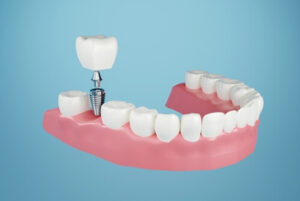 Consultation: Before any surgical procedure begins, an implant dentist will assess your oral health, take necessary X-rays, and discuss the best strategy tailored to your needs.
Consultation: Before any surgical procedure begins, an implant dentist will assess your oral health, take necessary X-rays, and discuss the best strategy tailored to your needs.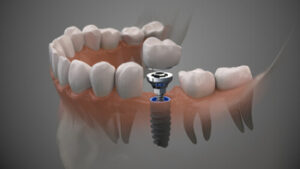 Biocompatible Materials
Biocompatible Materials